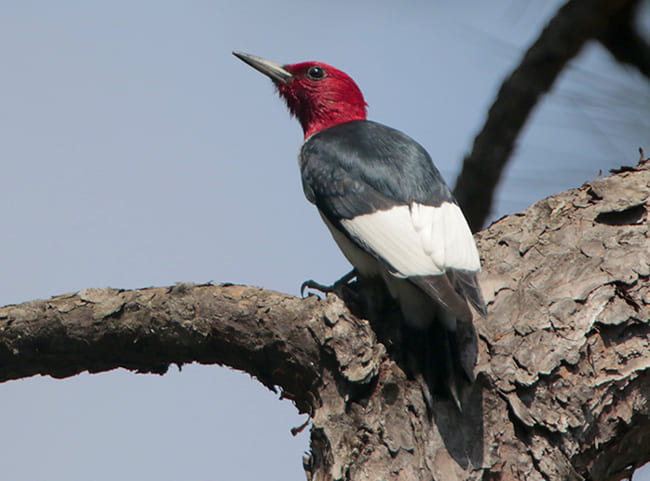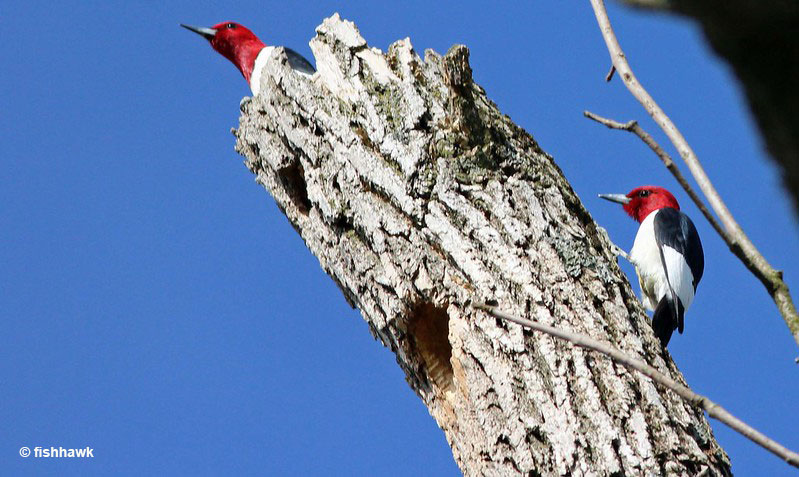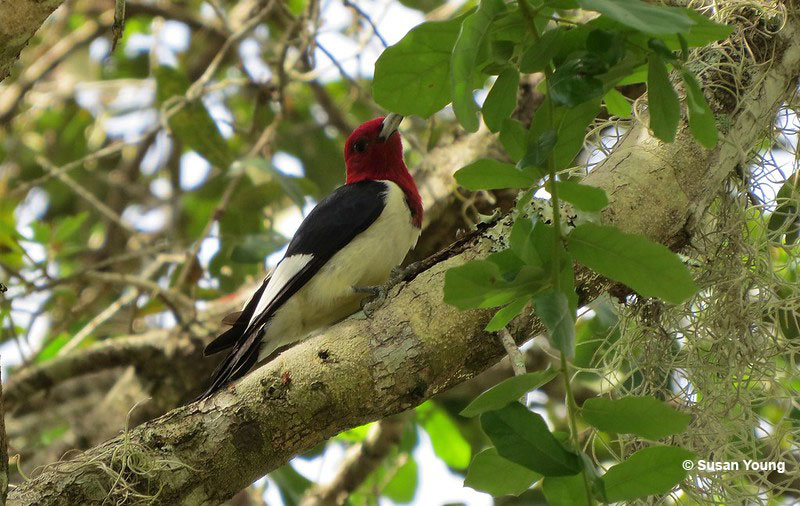The Red-headed Woodpecker is a medium-sized woodpecker. They have spike-like, powerful bills, stiff, short tails, and relatively large, rounded heads.
The gorgeous birds have earned the nickname “flying checkerboard” due to their bold pattern. These birds don’t act like most woodpecker species. They eat lots of beech nuts and acorns and are experts at catching insects in the air.
Red-headed Woodpeckers tend to inhabit pine savannahs, dead timber in swamps, or scattered, open woodlots in agricultural areas.
When in these areas, listen for drumming and tapping and walk slowly. Keep an eye out for the revealing flashes of black and white as these birds fly between perches.
On this page
Breeding Male
Adult Red-headed Woodpeckers have white underparts, large white patches in the wings, black backs, and bright-red heads. When perched, the large white wing patches make the lower back appear all white.
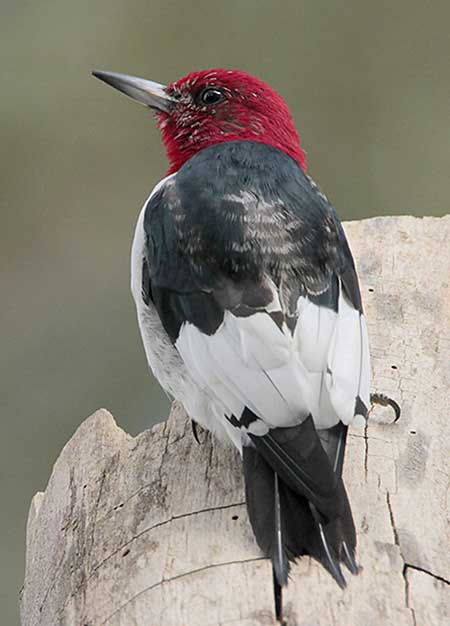
Image © Greg Lavaty
These birds are 7.5 to 9.1 inches (19 to 23 centimeters) long and weigh 2.0 to 3.2 ounces (56 to 91 grams). That makes them smaller than Northern Flickers and around the same size as a Hairy Woodpecker.
Female
Female Red-headed Woodpeckers look identical to breeding male Red-headed Woodpeckers.
Juvenile
Juvenile Red-headed Woodpeckers have white wing patches, rows of black spots near the trailing edge of the wing patches, and gray-brown heads. It takes 12 to 14 days for these birds to hatch. Both parents feed the juveniles and leave the nest at around 27 to 31 days. Parents will provide food for the juveniles for up to 6 weeks after they leave the nest.
Habitat
The Red-headed Woodpecker breeds in groves of dying or dead trees, deciduous woodlands with oak or beech trees, recent clearings, burned areas, river bottoms, beaver swamps, orchards, roadsides, farmland, parks, forest edges, and grasslands with scattered trees.
In earlier portions of the breeding season, these birds move from the interior of the forest to disturbed areas or forest edges. Partially dead to completely dead trees are crucial in their breeding areas for nesting cavities.
In the northern portions of their wintering range, they live in mature forests, especially oak-hickory, oak, maple, beech, and ash. In the southern portions of their range, they live in mature pine oak and pine forests.
Diet
Red-headed Woodpeckers eat seeds, fruits, and insects. Overall, one-third of their diet consists of animal material, and two-thirds of their diet consists of plant material. Insects they consume include cicadas, beetles, midges, grasshoppers, and honeybees.
They’re extremely skillful flycatchers among the North American woodpecker species; they usually catch insects in the air by locating them from a perch and then flying over to grab them. In addition, Red-headed Woodpeckers eat nuts, seeds, berries, corn, and other types of fruit. These birds have even been known to raid other birds’ nests to eat nestlings and eggs.
They forage up to 30 feet above the forest floor and on the ground in summer, whereas in winter, they forage in the trees. In the winter, these woodpeckers catch insects on warm days, but their diet mainly consists of nuts like beech nuts, pecans, and acorns.
Behavior
Red-headed Woodpeckers climb limbs and tree trunks like other woodpeckers do and will usually stay still for long periods of time. They are powerful fliers and fly pretty level in comparison to other woodpeckers.
Potential mates will play “hide and seek” with each other around telephone poles and dead stumps. Once mated, they can stay together for several years. Both male and female birds are aggressive and solitary during the winter and territorial during the breeding season.
These birds are quick to pick fights with a lot of other bird species, including the Pileated Woodpecker and European Starling.
Range (and seasonal changes)
Red-headed Woodpeckers are partial or short-distance migrants. They usually leave the western and northern portions of their range for the winter and go where acorn and beech nut crops are plentiful.
During migration, Red-headed Woodpeckers sometimes wander extensively in loose flocks. In the spring, they move during the nighttime and during the day in the fall.
Wing shape
Red-headed Woodpeckers have broad wings with rounded tips. They have a wingspan of 16.5 inches (42 centimeters).
Fun Facts
- Red-headed woodpeckers often symbolize creativity, life and vitality, adaptability, and strength of spirit. In addition, stories and legends about these birds associate them with guidance, prophetic knowledge, and wisdom.
- During the breeding season, potential mates will play “hide and seek” with each other around telephone poles and dead stumps.
- The Red-headed woodpecker is the only woodpecker in North America that stores food and covers it with bark.
- It can take 2 to 3 weeks for a Red-headed Woodpecker to excavate one hole.
Call
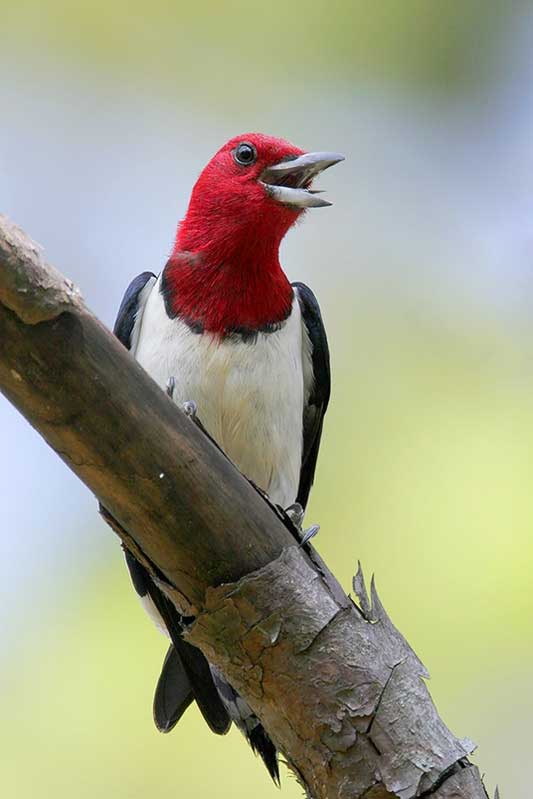
Red-headed Woodpeckers make all kinds of cackles, chirps, and other raucous calls. Their most common call is a hoarse, shrill tchur. It sounds similar to the Red-bellied Woodpecker’s call, but it rolls less and is higher-pitched. When Red-headed Woodpeckers chase each other, they make piercing charr-charr notes.
Red-headed Woodpeckers also drum on trees, tin roofs, the sides of houses, stovepipes, and utility poles to drive intruders out of their territory.
Drumming includes a staccato roll and a two-part hammering sound. In addition, these birds tap slowly on surfaces near a nesting cavity when communicating with their mates or choosing a nest.
Similar Species
Red-headed Woodpeckers are easily identifiable thanks to the red plumage on their heads that goes down to their necks. Still, there are some other species that have similar plumage.
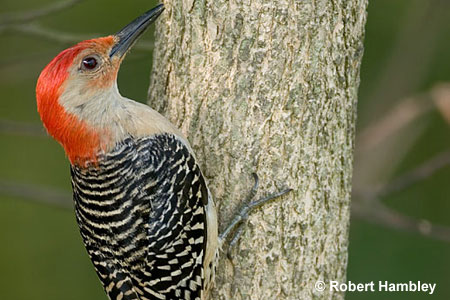
red-bellied woodpecker
Although the two look similar, when you’re taking a closer look, it’s easy to see how different Red-headed Woodpeckers and Red-bellied Woodpeckers really are.
Red-headed Woodpeckers are easy to identify thanks to the red plumage on their heads that goes down to their neck. Red-bellied Woodpeckers have some red on their heads, but it’s generally more vibrant and doesn’t cover their whole heads.
Another way to tell these two apart is by looking at the rest of their plumages. Red-bellied Woodpeckers have a white chest and patches of white and black on their backs and wings, while Red-bellied Woodpeckers have a barred look.
Frequently Asked Questions
Are Red-headed Woodpeckers rare?
Yes, the Red-headed Woodpecker is an uncommon bird. They have a breeding population of only 1.2 million.
Do Red-headed Woodpeckers migrate?
Yes, Red-headed Woodpeckers migrate. They’re partial or short-distance migrants. They usually leave the western and northern portions of their range for the winter and go where acorn and beech nut crops are plentiful.
What does a Red-headed Woodpecker nest look like?
Red-headed Woodpeckers nest in partially or completely dead trees. They either excavate or use naturally occurring cavities.

